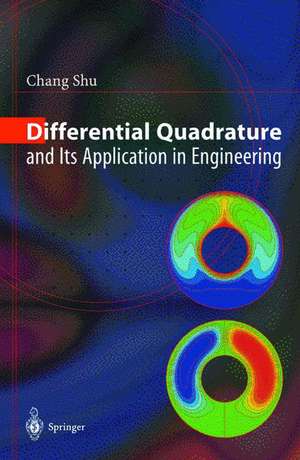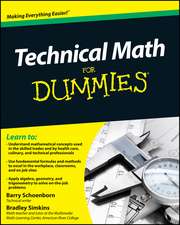Differential Quadrature and Its Application in Engineering
Autor Chang Shuen Limba Engleză Hardback – 13 ian 2000
The book contains material on:
- Linear Vector Space Analysis and the Approximation of a Function;
- Polynomial-, Fourier Expansion- and Exponential-based Differential Quadrature;
- Differential Quadrature Weighting Coefficient Matrices;
- Solution of Differential Quadrature-resultant Equations;
- The Solution of Incompressible Navier-Stokes and Helmholtz Equations;
- Structural and Vibrational Analysis Applications;
- Generalized Integral Quadrature and its Application in the Solution of Boundary Layer Equations.
Three FORTRAN programs for simulation of driven cavity flow, vibration analysis of plate and Helmholtz eigenvalue problems respectively, are appended. These sample programs should give the reader a better understanding of differential quadrature and can easily be modified to solve the readers own engineering problems.
| Toate formatele și edițiile | Preț | Express |
|---|---|---|
| Paperback (1) | 942.27 lei 6-8 săpt. | |
| SPRINGER LONDON – 11 oct 2012 | 942.27 lei 6-8 săpt. | |
| Hardback (1) | 947.80 lei 6-8 săpt. | |
| SPRINGER LONDON – 13 ian 2000 | 947.80 lei 6-8 săpt. |
Preț: 947.80 lei
Preț vechi: 1155.86 lei
-18% Nou
Puncte Express: 1422
Preț estimativ în valută:
181.36€ • 189.74$ • 150.66£
181.36€ • 189.74$ • 150.66£
Carte tipărită la comandă
Livrare economică 02-16 aprilie
Preluare comenzi: 021 569.72.76
Specificații
ISBN-13: 9781852332099
ISBN-10: 1852332093
Pagini: 360
Ilustrații: XVI, 340 p.
Dimensiuni: 155 x 235 x 25 mm
Greutate: 0.67 kg
Ediția:2000
Editura: SPRINGER LONDON
Colecția Springer
Locul publicării:London, United Kingdom
ISBN-10: 1852332093
Pagini: 360
Ilustrații: XVI, 340 p.
Dimensiuni: 155 x 235 x 25 mm
Greutate: 0.67 kg
Ediția:2000
Editura: SPRINGER LONDON
Colecția Springer
Locul publicării:London, United Kingdom
Public țintă
Professional/practitionerDescriere
In the past few years, the differential quadrature method has been applied extensively in engineering. This book, aimed primarily at practising engineers, scientists and graduate students, gives a systematic description of the mathematical fundamentals of differential quadrature and its detailed implementation in solving Helmholtz problems and problems of flow, structure and vibration. Differential quadrature provides a global approach to numerical discretization, which approximates the derivatives by a linear weighted sum of all the functional values in the whole domain. Following the analysis of function approximation and the analysis of a linear vector space, it is shown in the book that the weighting coefficients of the polynomial-based, Fourier expansion-based, and exponential-based differential quadrature methods can be computed explicitly. It is also demonstrated that the polynomial-based differential quadrature method is equivalent to the highest-order finite difference scheme. Furthermore, the relationship between differential quadrature and conventional spectral collocation is analysed.
The book contains material on:
- Linear Vector Space Analysis and the Approximation of a Function;
- Polynomial-, Fourier Expansion- and Exponential-based Differential Quadrature;
- Differential Quadrature Weighting Coefficient Matrices;
- Solution of Differential Quadrature-resultant Equations;
- The Solution of Incompressible Navier-Stokes and Helmholtz Equations;
- Structural and Vibrational Analysis Applications;
- Generalized Integral Quadrature and its Application in the Solution of Boundary Layer Equations.
Three FORTRAN programs for simulation of driven cavity flow, vibration analysis of plate and Helmholtz eigenvalue problems respectively, are appended. These sample programs should give the reader a better understanding of differential quadrature and can easily be modified to solve the readers own engineering problems.
The book contains material on:
- Linear Vector Space Analysis and the Approximation of a Function;
- Polynomial-, Fourier Expansion- and Exponential-based Differential Quadrature;
- Differential Quadrature Weighting Coefficient Matrices;
- Solution of Differential Quadrature-resultant Equations;
- The Solution of Incompressible Navier-Stokes and Helmholtz Equations;
- Structural and Vibrational Analysis Applications;
- Generalized Integral Quadrature and its Application in the Solution of Boundary Layer Equations.
Three FORTRAN programs for simulation of driven cavity flow, vibration analysis of plate and Helmholtz eigenvalue problems respectively, are appended. These sample programs should give the reader a better understanding of differential quadrature and can easily be modified to solve the readers own engineering problems.
Cuprins
1 Mathematical Fundamentals of Differential Quadrature Method: Linear Vector Space Analysis and Function Approximation.- 1.1 Introduction.- 1.2 Derivative Approximation by Differential Quadrature (DQ) Method.- 1.2.1 Integral Quadrature.- 1.2.2 Differential Quadrature.- 1.3 Analysis of A Linear Vector Space.- 1.3.1 Definition of A Linear Vector Space.- 1.3.2 Properties of A Linear Vector Space.- 1.4 Solution of Partial Differential Equations (PDEs) and Function Approximation.- 1.4.1 Two Basic Types of Solution for PDEs.- 1.4.2 High Order Polynomial Approximation.- 1.4.3 Fourier Series Expansion.- 1.4.3.1 General function.- 1.4.3.2 Even function.- 1.4.3.3 Odd function.- 2 Polynomial-based Differential Quadrature (PDQ).- 2.1 Introduction.- 2.2 Computation of Weighting Coefficients for the First Order Derivative.- 2.2.1 Bellman’s Approaches.- 2.2.2 Quan and Chang’s Approach.- 2.2.3 Shu’s General Approach.- 2.3 Computation of Weighting Coefficients for the Second and Higher Order Derivatives.- 2.3.1 Weighting Coefficients of the Second Order Derivative.- 2.3.2 Shu’s Recurrence Formulation for Higher Order Derivatives.- 2.3.3 Matrix Multiplication Approach.- 2.4 Error Analysis.- 2.4.1 The Function Approximation.- 2.4.2 The Derivative Approximation.- 2.5 Relationship Between PDQ and Other Approaches.- 2.5.1 Relationship Between PDQ and Finite Difference Scheme.- 2.5.1.1 Generation of Finite Difference Scheme.- 2.5.1.2 Relationship Between PDQ and Highest Order Finite Difference Scheme.- 2.5.2 Relationship Between PDQ and Chebyshev Collocation Method.- 2.6 Extension to the Multi-dimensional Case.- 2.6.1 Direct Extension for Regular Domain.- 2.6.2 Differential Cubature Method.- 2.7 Specific Results for Typical Grid Point Distributions.- 2.7.1 Uniform Grid.- 2.7.2 Chebyshev-Gauss-Lobatto Grid.- 2.7.3 Coordinates of Grid Points Chosen as the Roots of Chebyshev Polynomial.- 2.8 Generation of Low Order Finite Difference Schemes by PDQ.- 3 Fourier Expansion-based Differential Quadrature (FDQ).- 3.1 Introduction.- 3.2 Cosine Expansion-based Differential Quadrature (CDQ) for Even Functions.- 3.3 Sine Expansion-based Differential Quadrature (SDQ) for Odd Functions.- 3.4 Fourier Expansion-based Differential Quadrature (FDQ) for Any General function.- 3.5 Some Properties of Fourier Expansion-based Differential Quadrature.- 4 Some Properties of DQ Weighting Coefficient Matrices.- 4.1 Introduction.- 4.2 Determinant and Rank of DQ Weighting Coefficient Matrices.- 4.2.1 Definition and Properties of Determinant and Rank.- 4.2.2 Determinant and Rank of DQ Weighting Coefficient Matrices.- 4.3 Structures and Properties of DQ Weighting Coefficient Matrices.- 4.3.1 Definition of Centrosymmetric and Skew Centrosymmetric Matrices.- 4.3.2 Properties of Centrosymmetric and Skew Centrosymmetric Matrices.- 4.3.2.1 Properties of Centrosymmetric Matrices.- 4.3.2.2 Properties of Skew Centrosymmetric Matrices.- 4.3.3 Structures of DQ Weighting Coefficient Matrices.- 4.3.3.1 Structure of First Order DQ Weighting Coefficient Matrix.- 4.3.3.2 Structures of Higher Order DQ Weighting Coefficient Matrices.- 4.4 Effect of Grid Point Distribution on Eigenvalues of DQ Discretization Matrices.- 4.4.1 Stability of Ordinary Differential Equations.- 4.4.2 Eigenvalues of Some Specific DQ Discretization Matrices.- 4.4.2.1 The Convection Operator.- 4.4.2.2 The Diffusion Operator.- 4.4.2.3 The Convection-Diffusion Operator.- 4.5 Effect of Grid Point Distribution on Magnitude of DQ Weighting Coefficients.- 5 Solution Techniques for DQ Resultant Equations.- 5.1 Introduction.- 5.2 Solution Techniques for DQ Ordinary Differential Equations.- 5.3 Solution Techniques for DQ Algebraic Equations.- 5.3.1 Direct Methods.- 5.3.2 Iterative Methods.- 5.3.2.1 Iterative Methods for Conventional System.- 5.3.2.2 Iterative Methods for Lyapunov System.- 5.4 Implementation of Boundary Conditions.- 5.5 Sample Applications of DQ Method.- 5.5.1 Burgers Equation.- 5.5.2 Two-dimensional Poisson Equation.- 5.5.3 Helmholtz Eigenvalue Problem.- 6 Application of Differential Quadrature Method to Solve Incompressible Navier-Stokes Equations.- 6.1 Introduction.- 6.2 Governing Equations.- 6.2.1 Dimensional Form.- 6.2.2 Non-dimensional Form.- 6.2.3 Vorticity-Stream Function Formulation.- 6.3 Solution of Vorticity-Stream Function Formulation.- 6.3.1 Discretization of Governing Equations.- 6.3.2 Implementation of Boundary Conditions.- 6.3.2.1 Implementation of Boundary Condition for Vorticity.- 6.3.2.2 Implementation of Boundary Condition for Stream function.- 6.3.2.3 Implementation of Boundary Condition for Temperature.- 6.3.3 Solution Procedures.- 6.3.4 Some Numerical Examples.- 6.3.4.1 The Flow Past A Circular Cylinder.- 6.3.4.2 The Natural Convection in A Concentric Annulus.- 6.4 Solution of Incompressible Navier-Stokes Equations in Primitive Variable Form.- 6.4.1 Introduction.- 6.4.2 Pressure Correction Method.- 6.4.3 Two Approaches to Specify Boundary Condition for p’ and to Enforce Continuity Condition on the Boundary.- 6.4.3.1 Approach 1.- 6.4.3.2 Approach 2.- 6.4.4 Computational Sequence.- 6.4.5 Sample Application and Comments on the Two Approaches.- 6.4.5.1 Importance of Enforcing Continuity Condition on the Boundary.- 6.4.5.2 Comments on Performance of Two Approaches.- 7 Application of Differential Quadrature Method to Structural and Vibration Analysis.- 7.1 Introduction.- 7.2 Differential Quadrature Analysis of Beams.- 7.2.1 Governing Equations and Boundary Conditions.- 7.2.2 Numerical Discretization.- 7.2.3 Implementation of Boundary Conditions.- 7.2.3.1 The ?-technique.- 7.2.3.2 Modification of Weighting Coefficient Matrices.- 7.2.3.3 Direct Substitution of Boundary Conditions into Discrete Governing Equations.- 7.2.4 Numerical Example: Free Vibration Analysis of A Uniform Beam.- 7.3 Differential Quadrature Analysis of Thin Plates.- 7.3.1 Governing Equations and Boundary Conditions.- 7.3.2 Numerical Discretization.- 7.3.3 Implementation of Boundary Conditions.- 7.3.3.1 The 8-technique.- 7.3.3.2 Modification of Weighting Coefficient Matrices.- 7.3.3.3 Direct Substitution of Boundary Conditions into Discrete Governing Equations.- 7.3.3.4 General Approach.- 7.3.4 Numerical Example: Free Vibration Analysis of Square Plates.- 7.4 Differential Quadrature Analysis of Shells.- 7.4.1 Governing Equations and Boundary Conditions.- 7.4.2 Numerical Discretization.- 7.4.3 Implementation of Boundary Conditions.- 7.4.4 Numerical Example: Free Vibration Analysis of A Composite Laminated Conical Shell.- 8 Miscellaneous Applications of Differential Quadrature Method.- 8.1 Introduction.- 8.2 Application to Heat Transfer.- 8.3 Application to Chemical Reactor.- 8.4 Application to Lubrication Problems.- 8.5 Application to Waveguide Analysis.- 8.6 Solution of the Helmholtz Equation.- 8.7 Effect of Mesh Point Distribution on Accuracy of DQ Results.- 9 Application of Differential Quadrature to Complex Problems.- 9.1 Introduction.- 9.2 Multi-domain DQ Method.- 9.2.1 Topology of Interface.- 9.2.1.1 Patched Interface.- 9.2.1.2 Overlapped Interface.- 9.2.2 Multi-domain DQ Application in Fluid Mechanics.- 9.2.3 Multi-domain DQ Application in Solid Mechanics.- 9.2.4 Multi-domain DQ Application in Waveguide Analysis.- 9.3 DQ Application in Curvilinear Coordinate System.- 9.3.1 Coordinate Transformation.- 9.3.2 DQ Simulation of Incompressible Flows in Irregular Domains.- 9.3.3 DQ Vibration Analysis of Irregular Plates.- 9.3.3.1 Partial Transformation.- 9.3.3.2 Complete Transformation.- 9.3.3.3 Implementation of Boundary Conditions.- 9.3.3.4 Sample Application.- 9.4 Differential Cubature Method for Complex Problems.- 10 Generalized Integral Quadrature (GIQ) And Its Application to Solve Boundary Layer Equations.- 10.1 Introduction.- 10.2 Generalized Integral Quadrature (GIQ).- 10.2.1 One-dimensional Generalized Integral Quadrature.- 10.2.2 Error Analysis.- 10.2.3 Extension to Multi-dimensional Cases.- 10.2.4 Sample Application of GIQ Method.- 10.3 DQ-GIQ Algorithm to Solve Boundary Layer Equations.- 10.3.1 Stream Function as Dependent Variable.- 10.3.2 Primitive Variables as Dependent Variables.- 10.4 Steady Boundary Layer Solutions.- 10.4.1 One-dimensional Case.- 10.4.2 Two-dimensional Case.- 10.4.3 Three-dimensional Case.- 10.5 Unsteady Boundary Layer Solutions.- Appendices.- A. A Fortran Program for Simulation of Natural Convection in A Square Cavity.- B. A Fortran Program for Vibration Analysis of Rectangular Plates.- References.
Textul de pe ultima copertă
In the past few years, the differential quadrature method has been applied extensively in engineering. This book, aimed primarily at practising engineers, scientists and graduate students, gives a systematic description of the mathematical fundamentals of differential quadrature and its detailed implementation in solving Helmholtz problems and problems of flow, structure and vibration. Differential quadrature provides a global approach to numerical discretization, which approximates the derivatives by a linear weighted sum of all the functional values in the whole domain. Following the analysis of function approximation and the analysis of a linear vector space, it is shown in the book that the weighting coefficients of the polynomial-based, Fourier expansion-based, and exponential-based differential quadrature methods can be computed explicitly. It is also demonstrated that the polynomial-based differential quadrature method is equivalent to the highest-order finite difference scheme. Furthermore, the relationship between differential quadrature and conventional spectral collocation is analysed.The book contains material on:- Linear Vector Space Analysis and the Approximation of a Function;- Polynomial-, Fourier Expansion- and Exponential-based Differential Quadrature;- Differential Quadrature Weighting Coefficient Matrices;- Solution of Differential Quadrature-resultant Equations;- The Solution of Incompressible Navier-Stokes and Helmholtz Equations;- Structural and Vibrational Analysis Applications;- Generalized Integral Quadrature and its Application in the Solution of Boundary Layer Equations.Three FORTRAN programs for simulation of driven cavity flow, vibration analysis of plate and Helmholtz eigenvalue problems respectively, are appended. These sample programs should give the reader a better understanding of differential quadrature and can easily be modified to solve the readers own engineering problems.
Caracteristici
No other books on this subject in this area
Fortran programs attached allow easy practical application of the methods in the book
Fortran programs attached allow easy practical application of the methods in the book











